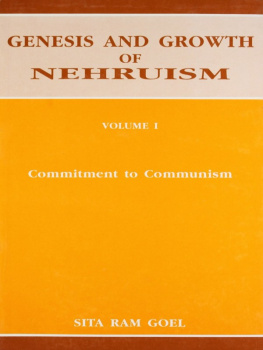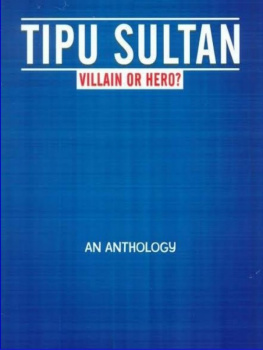How I Became a Hindu
Pages
How I Became a Hindu
Sitaram Goel
This book was produced in EPUB format by the Internet Archive.
The book pages were scanned and converted to EPUB format automatically. This process relies on optical character recognition, and is somewhat susceptible to errors. The book may not offer the correct reading sequence, and there may be weird characters, non-words, and incorrect guesses at structure. Some page numbers and headers or footers may remain from the scanned page. The process which identifies images might have found stray marks on the page which are not actually images from the book. The hidden page numbering which may be available to your ereader corresponds to the numbered pages in the print edition, but is not an exact match; page numbers will increment at the same rate as the corresponding print edition, but we may have started numbering before the print book's visible page numbers. The Internet Archive is working to improve the scanning process and resulting books, but in the meantime, we hope that this book will be useful to you.
The Internet Archive was founded in 1996 to build an Internet library and to promote universal access to all knowledge. The Archive's purposes include offering permanent access for researchers, historians, scholars, people with disabilities, and the general public to historical collections that exist in digital format. The Internet Archive includes texts, audio, moving images, and software as well as archived web pages, and provides specialized services for information access for the blind and other persons with disabilities.
Created with abbyy2epub (v.1.7.6)
HOW I BECAME A HINDU
SITA RAM GOEL
VOICE OF INDIA New Delhi
AUTHOR First published 1982 Second Reprint, 1987 Third Enlarged Edition, 1993 Third Reprint, 1998
All rights reserved. No part of this book may be reproduced, in whole or in part, in any form or by any means, electronic or mechanical, including photocopying, recording, or by any information storage retrieval system, without permission in writing from the publisher.
ISBN 81-85990-05-0
Published by Voice of India, 2/18, Ansari Road, New Delhi-110 002 and printed at Rajkamal Electric Press, B-35/9, G.T. Karnal Road, Delhi-110 033.
CONTENTS
One
From Arya Samaj to Mahatma Gandhi
Two
From Gandhism to Communism Three
Seeds that were to Sprout Four
Some Interesting Encounters
Five
Close to the Communist Party Six
Ram Swarup to the Rescue Seven
Back to Square One Eight
Return to my Spiritual Home Postscript
Nightmare of Nehruism
One
FROM ARYA SAMAJ TO MAHATMA GANDHI
(I promised this intellectual autobiography to Hashmat, some twenty years ago. Hashmat wrote frequently in the Organiser under the general heading "Pakistan X-Rayed". It is years since I lost track of him. Bull never forgot my promise. I wonder what I would have written twenty years ago. I wonder also how this story will shape if I wait for another twenty years. And I do not know what its worth is today. But I am impelled to write it because in todays India it is not sufficient to be a Hindu by birth. Hindu society and culture are under attack from several quarters. One has to be a convinced and conscious Hindu to meet and survive that attack. One has to find ones roots in Sanatana Dharma).*
I was bom a Hindu. But I had ceased to be one by the time I came out of college at the age of 22.1 had become a Marxist and a militant atheist. I had come to believe that Hindu scriptures should be burnt in a bonfire if India was to be saved.
It was fifteen years later that I could see this culmination as the explosion of an inflated ego. During those years of self-poisoning, I was sincerely convinced that I was engaged in a philosophical exploration of cosmic proportions.
How my ego got inflated to a point where I could see nothing beyond my own morbid mental constructions, is no exceptional story. It happens to many of us mortals. What is relevant in my story is the seeking and the suffering and the struggle to break out of that spiders web of my own weaving. I will fill in the filaments as I proceed.
My earliest memory of an awakening to interests other than those with which a young boy is normally occupied, goes back to when I was eight years old. My family was living in Calcutta. My father was a total failure as a broker in the jute goods market. But he was a great storyteller. He could hardly be called an educated person having spent only 2-3 years in a village school. But he had imbibed a lot of the traditional lore by attending kathas and kirtanas in his younger days. His knowledge of Hindu mythology, legendry heroes, and the lives of saints was prolific.
One fine evening he started telling me the lengthy and complex
story of the Makabharata. The narrative lasted for more than a month, each instalment lasting over an hour or so. I absorbed every event and episode with rapt attention and bated breath. The sheer strength of some of the characters as they strode across the story lifted me up and above the humdrum of everyday life, and made me dwell in the company of immortals.
The Makabharata has been my most favourite book ever since. I regard it as the greatest work ever composed. My yearning for reading this great story in print led to a funny episode a few years later. I was a student of the fifth standard in my village in Haryana. An Urdu magazine was publishing a verbatim translation of the Makabharata in monthly instalments. The only subscriber to it in our village was a retired veteran of the First World War. But he kept the series locked in his baithak (study), and stubbornly refused to lend them even to his own son who was my classmate. The two of us watched his timings in the baithak, broke into it via the skylight on the roof, read the instalments one after another, and restored them to their original resting place. The theft was never discovered.
The character that impressed me most in the Makabharata was, of course, Sri Krishna. His great words and deeds left me enthralled. The admiration was to deepen in later years till it became a worship. His holy name became a sacred mantra. Sri Krishna is the foundation, the middle, and the apex of the Makabharata. I am told by one who should know that Sri Krishna is the highest symbol of Truth, Beauty, Goodness and Power which the human psyche has thrown up.
But I was painfully surprised when a wise man in the village equated the Makabharata with Alha-Udal, and warned that the narration, even the possession, of these two stories always led to feuds and bloodshed. I have read Alha-Udal also, the entire 52 martial episodes rendered into sonorous verse by Matrumal Attar. And I feel very strongly that the comparison is absolutely superficial, and the belief purely superstitious. Hindus in North India have neglected the Makabharata for a long time. The very fact that the Makabharata has come to be equated with Alha-Udal in the popular mind in the north is indicative of a great intellectual and cultural decline.
To return to my story, while still in Calcutta I made my first contact with another mighty scripture, the Granth Saheb of Sri Garibdas. This Jat saint of Haryana has been the patron saint of my family ever since an ancestor of ours, who was the saints contemporary, became his votary in the first half of the 18th century. We revere him as the Satguru (true teacher) who was an avatara of the Highest Being. He
was totally illiterate but composed and sang some 18000 verses of very sublime poetry which scales ihe highest spiritual heights. The story goes that my ancestor would not have his first morning sip of water unless he had paid homage to the saint who lived at a distance of 4 miles from our village.















